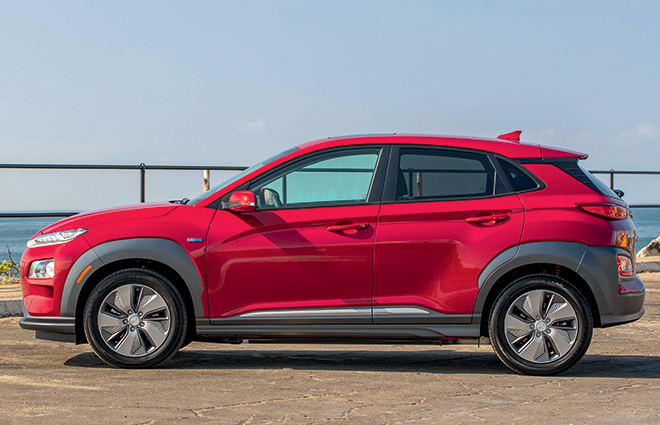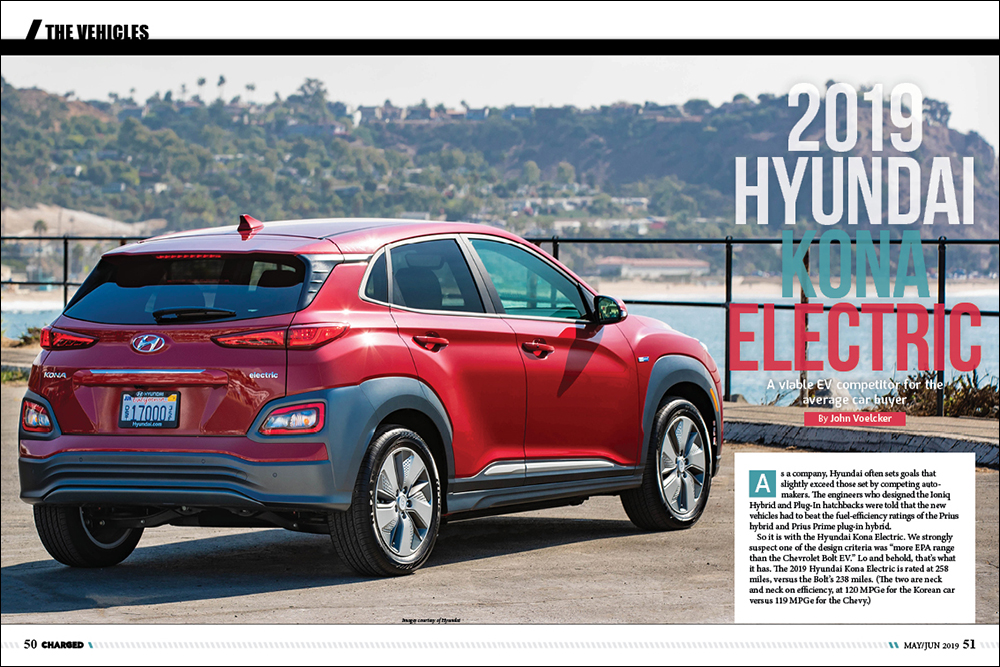As a company, Hyundai often sets goals that slightly exceed those set by competing automakers. The engineers who designed the Ioniq Hybrid and Plug-In hatchbacks were told that the new vehicles had to beat the fuel-efficiency ratings of the Prius hybrid and Prius Prime plug-in hybrid.
So it is with the Hyundai Kona Electric. We strongly suspect one of the design criteria was “more EPA range than the Chevrolet Bolt EV.” Lo and behold, that’s what it has. The 2019 Hyundai Kona Electric is rated at 258 miles, versus the Bolt’s 238 miles. (The two are neck and neck on efficiency, at 120 MPGe for the Korean car versus 119 MPGe for the Chevy.)
In other words, the only electric cars with more rated range all come from Tesla. Even the long-awaited 2019 Nissan LEAF Plus comes in at only 215 or 226 miles.


We spent 10 days and more than 500 miles with a Kona Electric in the San Francisco Bay Area during March. Our residence had no provisions for charging, making this a good test of a long-range electric car. We used the Kona just as we would any other car: we drove it wherever needed, at prevailing speeds, and charged opportunistically at public stations. Overall, we paid for two fast charging sessions and one Level 2 session, and used a free Level 2 station in a suburban office park while there on business.
We concluded that the Kona Electric is an entirely viable competitor to the Chevy Bolt EV. The big question, as with any new EV, will be to what extent Hyundai makes the cars available outside California and a small handful of other states.


The pros
We’ve never been fans of the gasoline Kona’s design. The busy accents, scoops, vents, plastic wheel-arch outlines and so forth all add up to a small SUV that looks like it’s trying way too hard.
The Kona EV has a smoother, calmer front end with a fetching dimple pattern over the blanking plate where the grille would have been. While we still aren’t fond of the grey plastic body add-ons, our test car’s maroon color (Pulse Red) made them somewhat less obvious.


The electric Kona has a quieter, more adult range of available colors than the louder, often neon tones used on the gas version. But while the Kona Electric is less upright than the Bolt EV, we’re not convinced either one has striking visual appeal. In that respect, the latest LEAF probably pulls ahead – and Tesla’s Model 3 is in an entirely different race.
However, the Kona shines with a well-executed and reassuringly “normal” interior. For several years, Hyundai has provided interiors that require little instruction, and central touchscreens intuitive enough to use without training. The quality of the knobs and switches is a bit better than those of the latest LEAF, and the design is not nearly as futuristic as that of the Bolt EV. Some EV fans find the Bolt’s futurism appealing, but we think your average buyer will be reassured by the electric Kona’s predictability. Most of the controls work just as the ones in the gasoline version do, with adaptations as needed, which seems both practical and a smart way to appeal to mass-market shoppers.


One area in which the Kona definitely beats the Bolt is its front seats. The thin, narrow seats of the Bolt EV suit some people fine – us included – but they’re a huge sore point with enough owners and buyers that we urge shoppers to test-drive a Bolt for an hour or so to make sure they’re tolerable. The Kona and LEAF, on the other hand, have conventional seats that should fit conventional people just fine.
As we were facing a highway journey of more than 100 miles in our first 24 hours with the car, we started out in Eco mode to preserve range. While the car wasn’t snappy in this mode, it proved fine for the majority of our running around. Normal mode was peppier, at a slight cost in range, and Sport mode was downright fun and speedy – at a rather greater hit to the range estimate.


For highway driving, we left the Kona in Eco mode, used the adaptive cruise control wherever possible, and enjoyed a calm ride. On twisty roads, handling was confident and sure-footed, owing something to the more sophisticated trailing-arm rear suspension that the EV uses in place of the gasoline version’s twist beam.
We noticed that the electric Kona had a remarkably loud whine at low travel speeds. Finally, we realized it was the car’s low-speed pedestrian alert, issuing a sound unlike any others we’ve heard. It could be described as a sort of spaceship noise – if your local spaceship made a low howling whine – that we found distinctive and amusing. (Your experience may vary.)


The cons
The Kona Electric had a few distinct disadvantages compared to the Chevy Bolt. One is rear-seat legroom: there was very little. I wasn’t able to sit comfortably behind myself, and fitting four US-size adults in the car proved to be an exercise in minimizing harm. Riders sit more upright in the taller Bolt, but its quarters are less cramped. The Kona’s rear cargo space is generous, however.
As is the case with most EVs, when the Kona Electric is driven predominantly on highways, the combined range estimates don’t measure up to the advertised number. The Kona Electric is rated at 108 MPGe on the highway, 10 percent lower than the combined figure, but we’d estimate the reduction at closer to 15 percent when traveling on hilly California highways at prevailing speeds – even in the Eco mode that we used for the majority of our travels. However, that still left the car with 200-plus miles of range, which worked fine for us.
The lack of all-wheel drive in what’s billed as a crossover is a drawback that this car sadly has in common with the Bolt. Where we come from, any SUV or “crossover utility” has to have AWD available – but if you want an AWD Kona, you have to get a gasoline engine.
Experienced EV drivers may find the electric Kona’s oddest feature to be its regenerative braking control. Unlike the BMW i3, Chevy Bolt, Nissan LEAF and other electrics, it’s impossible to set the Kona Electric to continuous one-pedal driving.


The paddles behind the steering wheel increase (left) or decrease (right) the level of regeneration, and holding in the left paddle steadily dials up regen until the car stops. To bring the car to a standstill without touching the brake, a driver must use the paddle at every intersection.


Also, each of the three power modes (Eco, Normal, Sport) sets a different level of regen (1, 2, and 3, respectively). That means a driver who wants the strongest regen either has to use the least-efficient mode (Sport) plus the left paddle, remember to click the left paddle three times after every stop to boost the regen level to 3, or spend an inordinate amount of time clicking the paddle to slow down at every intersection.
It’s a baffling system, and Hyundai engineers and product managers couldn’t provide a simple, coherent answer as to why they hadn’t included an optional one-pedal driving mode, like Nissan’s ePedal on the LEAF. What Hyundai has built may be less unfamiliar to electric-car novices, but that shouldn’t preclude also giving experienced drivers what they want. The lack of seamless one-pedal driving was our biggest gripe with the Kona Electric.
How will it do?
The company says officially that the electric Kona can be ordered by any dealer, but field reports on earlier plug-in Hyundai models last year contradicted that. If you’re not in California or a few other states, you may have to work to find a Hyundai dealer willing to order you a Kona Electric.
Reports in early 2019 indicated that Hyundai dealers, even in California, knew little about the car, couldn’t tell shoppers when it would arrive or how many they would receive, and sometimes tried to steer them from electric to gasoline Konas. Other reports detailed price-gouging, from $5,000 to $8,000 over sticker, at a few dealerships.


That too is hardly unique to Hyundai, but we hope it will get worked out over time – especially since Hyundai almost certainly loses money on every Kona Electric it sells. The company has lowered its development costs by creating Kona underpinnings designed from the start to accommodate either a larger underfloor battery pack or a gasoline drivetrain.


The specs
For the record, that pack has a listed energy capacity of 64.0 kWh, and the motor driving the front wheels has a peak output of 150 kW (201 hp). The Kona Electric is also said to be able to fast charge at “up to 100 kW.” Although almost no CCS stations that can deliver that exist today in the US, they’ll arrive steadily over the car’s lifetime. In practice, the rate appears to be about 80 kW, and that only for a portion of the charging curve.


Every Hyundai Kona Electric comes with a variety of active safety and equipment features as standard equipment: blind-spot alert, automatic emergency braking, adaptive cruise control, active lane control and a driver-attention monitor. Android Auto and Apple CarPlay are also standard. There are three trim levels: SEL, Limited, and Ultimate. The Limited version adds a power driver’s seat, premium audio system, leather seats, and LED lights. The top-of-the-line Ultimate adds a built-in navigation system, parking sensors and the addition of stop-and-go capability to the adaptive cruise control.
Our top-of-the-line 2019 Hyundai Kona Electric Ultimate carried a total sticker price of $45,830. The base price of the Ultimate was $44,650, a whopping $8,200 more than the standard SEL version. Aside from $135 for carpeted floor mats – plus a mandatory $1,045 delivery charge – it had no further options. The Kona Electric is eligible for a $7,500 federal income tax credit and a $2,500 California purchase rebate, among other incentives.
This article appeared in Charged Issue 43 – May/June 2019 – Subscribe now.



















































